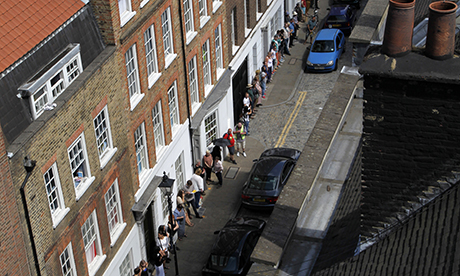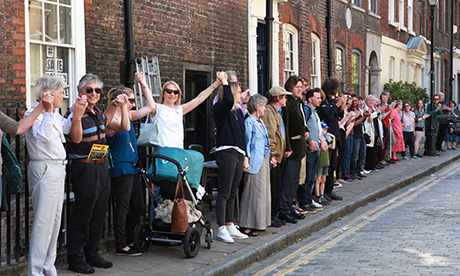Hundreds link arms in human chain as Norton Folgate decision looms
More than 300 people formed a protective ‘human chain’ around a cluster of heritage buildings in Shoreditch on Sunday ahead of a meeting that will decide their fate.
Campaigners opposing proposals by developer British Land, led by historian Dan Cruickshank and organised by the Spitalfields Trust, joined hands and surrounded the site, known as Norton Folgate.
The controversial application, which has received over 550 objections, will be decided at a Tower Hamlets council meeting on 21 July.
British Land argues that its Blossom Street scheme will bring many vacant or underused buildings in the area back into use and provide much-needed flexible office space.
But campaigners from the Spitalfields Trust claim that 70 per cent of the site, which sits in the Elder Street Conservation area, is under threat of demolition.
The interiors of 18th century houses on Norton Folgate and the Blossom Street warehouses will be turned into “shells”, campaigners say. New buildings proposed for the site are “too tall” and at 9-13 storeys “fail to reflect” local character.
Plans for double basements up to eight metres deep dug across much of the site have also prompted fears over the structure of the buildings, while the campaigners have said the area’s unique streetscape will be replaced with “inflexible monolithic structures”.
Historic England, formerly English Heritage, said that the scheme which is supported by site’s freeholders the City of London Corporation, will bring buildings that have lain empty and “decaying for decades” back into use.
Proposals ‘fully formed’
Tension has been mounting ahead of the planning decision and last month British Land wrote an open letter to Spitalfields Trust complaining the group was misrepresenting its plans.
The developers said the group had been publicly characterising the development as consisting of “glass and steel offices” and “corporate plazas”, and refusing to respond to their consultations.
But the Spitalfields Trust argues the developers conducted the public consultation with the proposals already “fully formed”.
Oliver Leigh-Wood, Administrator of Spitalfields Trust said: “It wasn’t a consultation. It was them with their team of architects telling us what they were going to do. What is the point in going on replying when they have completely lost our trust?”
Many campaigners battling to ‘Save Norton Folgate’ are on familiar ground. Forty years ago campaigners including the then Poet Laureate Sir John Betjeman fought off the same developers in their attempts to save historic 18th century silk weavers’ houses in Elder Street from demolition.
Mr Leigh-Wood said: ‘After nearly forty years of fighting for the future of Spitalfields, it is extremely alarming to find that the City of London Corporation have secretively bought up a large part of the Elder Street Conservation Area and are now encouraging British Land to apply for its almost total destruction”.
A British Land spokesman told the Hackney Citizen: “The Blossom Street development has been sensitively-designed by four teams of architects to be entirely sympathetic to the local area, at the same time as helping local businesses needing new office space.”


